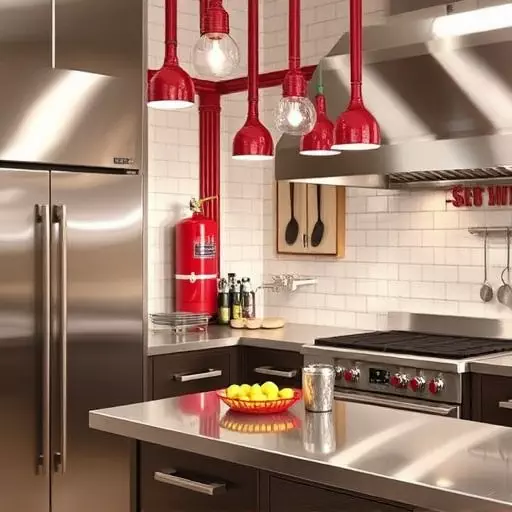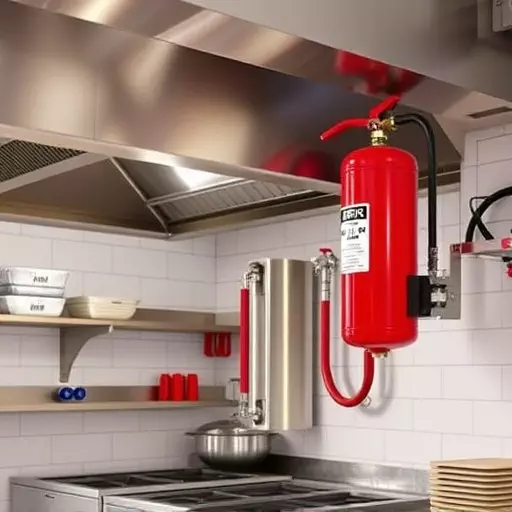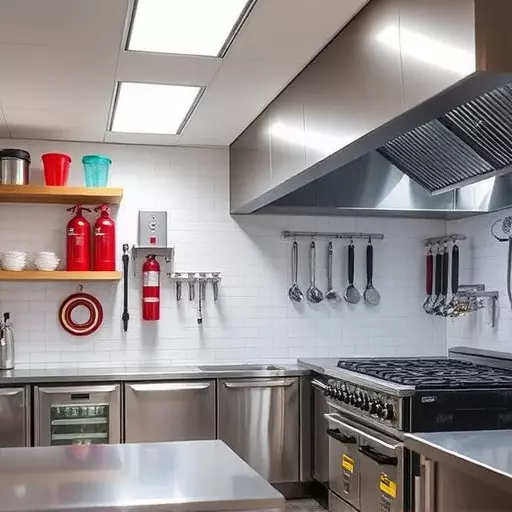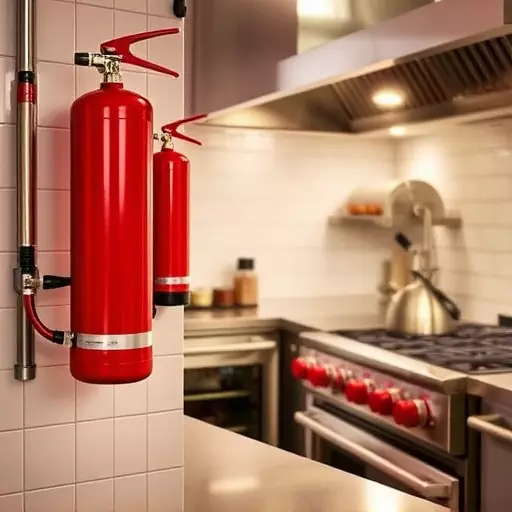In Spring Lake, Kitchen Fire Suppression Systems are a vital component for both residential and commercial kitchens due to their elevated risk of fires. These systems are expertly designed to swiftly detect and suppress fires, particularly in the early stages, using specialized agents like wet chemicals, which effectively extinguish flames without causing extensive water damage or exacerbating the situation. The benefits of installing such a system include enhanced safety, regulatory compliance with local fire codes, potential reductions in insurance premiums, and protection of both lives and assets. For commercial establishments, these systems not only ensure compliance but also safeguard the business's reputation by providing a robust defense mechanism against kitchen fires. The installation process is critical, involving careful placement of nozzles for comprehensive coverage, adherence to NFPA standards, and regular maintenance checks to guarantee optimal performance when needed. In summary, for Spring Lake residents and businesses, investing in Kitchen Fire Suppression Systems Spring Lake represents a prudent decision for immediate fire protection and long-term financial savings.
kitchen fire suppression systems spring lake plays a pivotal role in safeguarding against culinary blazes. This article delves into the critical aspects of these systems, from their installation to compliance and regulations. Understanding Kitchen Hood Fire Suppression Systems for Spring Lake Residents sets the stage for homeowners and business owners to recognize the Benefits of kitchen fire suppression systems, which extend beyond mere safety—they offer peace of mind and protection of property. We’ll explore The Installation Process of Efficient Kitchen Fire Suppression Systems, ensuring adherence to local standards. Additionally, we’ll examine Types of Kitchen Fire Suppression Agents and Their Role in Safety, ensuring you are well-informed on the best practices for fire prevention in your Spring Lake kitchen.
- Understanding Kitchen Hood Fire Suppression Systems for Spring Lake Residents
- The Installation Process of Efficient Kitchen Fire Suppression Systems
- Advantages of Implementing a Kitchen Fire Suppressions System in Your Home or Business
- Types of Kitchen Fire Suppression Agents and Their Role in Safety
- Compliance and Regulations Governing Kitchen Hood Fire Suppression Systems in Spring Lake
Understanding Kitchen Hood Fire Suppression Systems for Spring Lake Residents

Kitchen hood fire suppression systems are a critical safety feature for any Spring Lake household or commercial establishment that handles cooking with potential fire risks. These systems are designed to detect a fire in its early stages and deploy an extinguishing agent, such as wet chemical agents, to suppress the flames quickly and effectively. Understanding the intricacies of these systems is essential for Spring Lake residents who prioritize safety and want to safeguard their property from the devastating effects of a kitchen fire.
For Spring Lake residents considering the installation of a kitchen fire suppression system, it’s crucial to understand the benefits these systems offer. Unlike traditional water-based sprinkler systems, kitchen fire suppression systems are specifically engineered to handle grease and electrical fires commonly found in kitchens. They provide a swift response time, minimize water damage, and ensure that the fire is contained without causing further hazards. The installation of such a system can not only save lives but also protect one’s investment in the home or business. It’s an investment in peace of mind, knowing that should a fire occur, it will be suppressed promptly and with precision, reducing potential damage and allowing for a quicker return to normal operations.
The Installation Process of Efficient Kitchen Fire Suppression Systems

When integrating efficient kitchen fire suppression systems in commercial establishments such as those in Spring Lake, it is crucial to adhere to a meticulous installation process to ensure optimal performance and safety. The installation of a kitchen fire suppression system should commence with a thorough assessment of the kitchen layout and potential fire risks. This initial step involves identifying all cooking equipment and the specific types of fires they are most susceptible to. Once the risk areas are mapped out, the next phase entails selecting the appropriate nozzles and agents that align with the National Fire Protection Association (NFPA) standards. These systems typically employ wet chemical agents designed to effectively extinguish Class K fires, which are common in kitchen settings involving deep fat fryers.
The actual installation process is a multi-step procedure that begins with the precise positioning of nozzles above cooking appliances, ensuring complete coverage without obstruction. The piping for the fire suppressant must be strategically placed to allow for rapid deployment while also complying with local building codes and regulations. The system’s control panel, which acts as the command center for activation, is then installed in a location easily accessible by staff. Regular inspection and maintenance are integral post-installation practices to guarantee the kitchen fire suppression system operates flawlessly when needed. For businesses in Spring Lake considering the benefits of kitchen fire suppression systems, it’s evident that the investment not only adheres to safety regulations but also protects lives, assets, and the reputation of the establishment. These systems provide a reliable layer of defense against fire hazards, which are an unfortunate reality in any commercial kitchen.
Advantages of Implementing a Kitchen Fire Suppressions System in Your Home or Business

Kitchen Fire Suppression Systems in Spring Lake provide a robust line of defense against fire hazards, particularly in commercial settings and increasingly in residential kitchens. The benefits of implementing such a system are manifold. For one, these systems are specifically designed to detect and extinguish fires that originate from flammable materials commonly found in kitchen environments. Upon sensing abnormal heat or combustion byproducts, the suppression system releases a chemical agent that smothers the fire, effectively preventing it from spreading and causing extensive damage. This swift intervention can save lives and reduce the risk of costly property destruction.
Moreover, the installation of a kitchen fire suppression system is a proactive measure that can significantly lower insurance premiums, as the presence of such a system demonstrates a commitment to safety. It’s also a critical component for maintaining compliance with local fire codes and regulations, particularly in commercial establishments where kitchen fires pose a higher risk due to the volume of cooking activities. The benefits of kitchen fire suppression systems extend beyond immediate fire protection; they offer peace of mind, knowing that in the event of an emergency, a reliable system is ready to respond. For those in Spring Lake considering the installation of a kitchen fire suppression system, it’s clear that the advantages are both immediate and long-term, encompassing safety, compliance, and financial security.
Types of Kitchen Fire Suppression Agents and Their Role in Safety

kitchen fire suppression systems play a pivotal role in safeguarding commercial and residential kitchens from the ravages of fire. These systems are meticulously designed to detect, control, or extinguish fires in their incipient stages. The efficacy of such systems hinges upon the type of fire suppression agent they employ. There are essentially four types of agents used in kitchen fire suppression systems: wet chemical, dry chemical powder, water mist, and gas-based systems. Wet chemical agents are commonly found in kitchen fire suppression systems in Spring Lake due to their effectiveness against Class F fires involving fats and oils. These agents react quickly upon contact with the flammable material, forming a harmless solid barrier that cuts off the oxygen supply, smothering the fire.
Kitchen fire suppression system installation must be performed by certified professionals who understand the nuances of each system type to ensure optimal performance. For instance, dry chemical powder systems are suitable for Class B and Class K fires involving flammable liquids and grease, respectively. Water mist systems, on the other hand, utilize high-pressure nozzles to disperse fine water droplets that absorb heat faster than conventional water, making them effective for Class A fires, as well as complementing wet chemical agents in controlling deep fat fires. Lastly, gas-based fire suppression systems use clean agents that extinguish flames without leaving any residue, ideal for sensitive environments like electronics storage areas within or adjacent to kitchens. The benefits of kitchen fire suppression systems are manifold: they protect lives and property, minimize damage, comply with fire safety regulations, and contribute to the continued operation of businesses. In Spring Lake, where the culinary scene thrives, these systems are a critical component of risk management strategies for any establishment dealing with cooking operations.
Compliance and Regulations Governing Kitchen Hood Fire Suppression Systems in Spring Lake

In Spring Lake, compliance with stringent fire safety regulations is paramount, especially for commercial kitchens where the risk of fires is heightened due to the presence of cooking equipment and flammable materials. The installation of Kitchen Fire Suppression Systems in Spring Lake adheres to a set of comprehensive guidelines established by both local ordinances and the National Fire Protection Association (NFPA). These guidelines are designed to ensure that commercial kitchens are equipped with the most effective fire protection measures available, namely systems that can detect, control, and extinguish fires swiftly before they escalate into larger conflagrations. The Kitchen Fire Suppression System Spring Lake mandates are not arbitrary; they are based on extensive research and data that underscore their importance in safeguarding life, property, and the continuity of business operations.
The benefits of installing a kitchen fire suppression system are manifold. These systems are specifically engineered to combat fires caused by cooking grease or electrical malfunctions, which are common hazards in kitchen environments. By using an agent that effectively suppresses fire without causing damage to kitchen equipment or posing health risks to occupants, these systems provide a layer of protection that is critical in preventing catastrophic events. Moreover, the presence of a certified and properly maintained kitchen fire suppression system can reduce insurance premiums for commercial kitchens in Spring Lake, reflecting the lower risk profile associated with establishments that prioritize fire safety. Prospective kitchen operators are encouraged to explore the installation of these systems not only as a compliance measure but also as an investment in the long-term success and safety of their culinary ventures.


